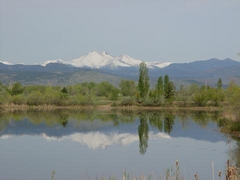Back in 1978, Cray Research Inc. was on top of the world in the supercomputer market. Led by the legendary Seymour Cray out of a small laboratory in Chippewa Falls, Wisconsin, their first super-computer, the CRAY-1 was a big success in the scientific market. Only about ten per year could be manufactured but at a price tag of $8 million and with a backlog of orders fueled by cold war research funding from national labs, Seymour Cray was free to move on to design the CRAY-1 successor, which was naturally called the CRAY-2.
Thinking his Chippewa Falls team needed some competition, Seymour Cray hired G. Stuart Patterson from Boulder's National Center for Atmospheric Research (NCAR) in 1979 to establish a new Cray Research lab in Boulder called Cray Labs. Patterson and Cray had become friends over the years, and NCAR was the first paying customer of the CRAY-1. The direction of the Boulder lab was to explore new ideas and technology (VLSI) for the CRAY-2 while the Wisconsin team would continue evolving their current supercomputer architecture.
One of Patterson's first tasks was to have a new building constructed. The site chosen was on Mitchell Lane in northeast Boulder, not too far from the airport. The beautiful building was arranged in a "C" shape, just like the arrangement of the CRAY-1 itself:
The "C" shape of the computer allowed wiring lengths to be optimized to get the most speed out of the system, which came to a peak of about 80 million floating point operations per second, a number that was stunning back then. That's the cooling system (Freon and piping) that you see in the base of the unit, covered cleverly with upholstery. Cray wanted technicians to have a comfortable place to sit while servicing the computer.
A short visit today to the Cray Labs building at 3375 Mitchell Lane shows its curved shape:
A satellite view shows it, too.
Cray Labs tried to recruit some of the Chippewa Falls engineers but that was difficult due to the significant housing and cost of living differences between a small town in Wisconsin and Boulder. Only a few made the move. Even in the early 1980s, Boulder was an expensive place to live.
Unfortunately, Cray Labs lasted just a few years. It was closed in 1982 due to some disagreements that Patterson and Cray had with their CEO.
Wild Oats was a tenant of the building at least in the early part of the previous decade and it was also extended to twice its original size during that time. In 2009, the building was sold to the University Corporation for Atmospheric Research (UCAR) for $5.3M. Probably a good price at the time since that was during the economic downturn.
In 2010, the building was named after Dr. Richard Anthes, a long time UCAR administrator.
Probably not many know the story of the building shape anymore but these folks do, and they even found a hot spot in front of the building from the sun's reflection off the parabolic shaped building.
A different city in Colorado would play prominently in another chapter of Seymour Cray's life but I'll save that for another post in the future.
A lot of the information here comes from the great book, "The Supermen: The Story of Seymour Cray and the Technical Wizards behind the Supercomputer" by Charles J. Murray (1997).
You can see NCAR's retired CRAY-1 (serial number 3) on display at the NCAR Mesa Laboratory that sits above Boulder.

 One citizen's view of Longmont, Colorado, USA.
One citizen's view of Longmont, Colorado, USA.








No comments:
Post a Comment